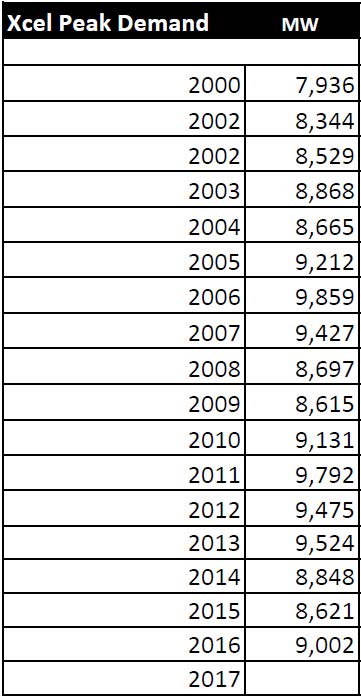Center of the American Experiment – Conflatulence!!
October 30th, 2017

These folks drive me crazy! Katherine Kersten has been on my list since the 80s when she wrote an editorial in the STrib about student loans, praising the Reagan cuts to student loans, and major decreases in income limits for “need based” student loans, just at the time I was winding up my BA and trying to get into law school. Who paid for her legal education? Anyway, yeah, obviously we don’t see eye to eye on anything, but this latest blather from them goes beyond a difference of opinion, to a too frequent spewing of conflatulence. And when I see this, yeah, I get on a rant too, it’s kind of disjointed, so I’ll be reworking soon. These claims are so insidious, because the facts do take some digging and some sifting. Add to that there is so much misinformation going on about transmission, about the Clean Power Plan… GRRRRRRRRRR…
Check this out:
Yeah, this CAE thing is going around, it’s arrived in my inbox via clients working on wind projects, it’s arrived via a transmission person from ND who put it on my facebook page via a WindAction post, which cut and pastes another “reporters” blog about the CAE “Report.” Playing “telephone” and we know how that goes… So let’s go straight to the horse’s … well, the other end.
This CAE “Report” is taking multiple things, trying to patch together an argument they want to make, but the patches aren’t holding. This comes on the heels of another report that found its way into my inbox with the claim that wind is very expensive, that it costs about 8 times the PPA cost because it’s intermittent, and because of that, they added in cost of power to cover when wind isn’t blowing (ummmm, you only pay for what you use, at the PPA price, DOH!).
Point by point in the “report” from CAE, they claim:
Minnesota has lost its advantage on electricity
That’s true! But sorry, CAE, it’s not because of wind. Rates have gone sky high in Minnesota for a couple of reasons. 1) Wholesale deregulation allowing sales from any Point A to any Point B, and 2) Transmission for coal and whatever else, from every Point A to every Point B. It is NOT 3) Wind is higher priced, because it is not.
Reason one that are rates are as high as Illinois rates? The economics of deregulation aren’t rocket science. When you have something to sell, you sell to the highest bidder. If someone else wants it, then they have to pay the going rate. A good resource on how we got to where we are is “The Economics of Regulation: Principles and Institutions,” by Alfred E. Kahn. It’s a major tome, but hey, just read Chapter 2, the chapter on electricity, “The Traditional Issues in the Pricing of Public Utility Services. Then, go back and read the introduction, where it gets into building more capacity than is needed, and the burden on ratepayers when utilities go overboard, particularly relevant when we get to the next point, that of overbuilding, and also consider the 105+ coal plants proposed but not built, including many coal gasification plants (i.e., Excelsior Energy’s Mesaba Project here in Minnesota and the NRG plant in Delaware, both of which I helped tank. The Mesaba Project provided much needed details about the technical problems and economics of coal gasification and the impossibility of carbon capture and storage that doomed any project from the get-go. IGCC – Pipedreams of Green & Clean), and the economic and technological disasters of the new Vogtle and V.C. Summer nuclear plants, and two coal gasification plants in Edwardsport , Indiana (coal gasification off more than on, often down completely) and Kemper IGCC in Mississippi (over $7 billion and now burning natural gas) that got off the drawing board but are economic disasters with ratepayers holding the bag.
Take a look at the cost of electricity, in real time:
FYI, here’s some wallpaper for ya, with the MISO Market LMP price in real time (keep in mind, this is spot market, so prices higher than PPA prices):
https://www.misoenergy.org/MarketsOperations/RealTimeMarketData/Pages/LMPContourMap.aspx
Check this slide from FERC info on EIA page:
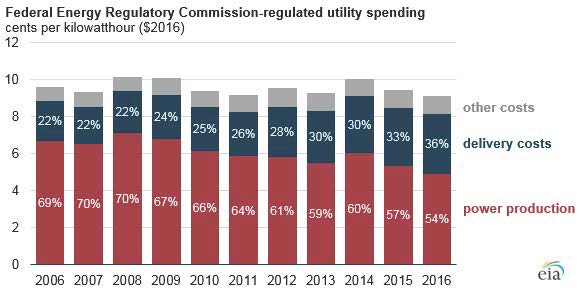
What? Delivery costs? Oh, TRANSMISSION!! (full story from EIA HERE)
Note also, from the same EIA post, the shift away from Power Purchase Agreements that came with the decrease in demand electricity glut:

Now, let’s move on to 2) Transmission for coal and whatever else may happen to be there, from every Point A to every Point B.
When you’re thinking about this, and about all the whining about shutting down coal plants, remember that the older very high priced to operate coal plants are being shut down. What about other plants? If all, if the majority, of coal plants were shut down, what would that mean for the transmission system? This is important — if those plants were shut down, there would be lots of room on the transmission system. But they didn’t. Instead, they built this huge transmission overlay called CapX 2020, at a cost of over $2 BILLION, and are now building the MISO 17 project MVP Portfolio (see MVP Dashboard — now up to $6.6 BILLION). MISO is now talking about a Regional Transmission Overlay above those (click on the maps in the link, AAACK!). Check the 20170131 EPUG Preliminary Overlay Ideas List. Get your pocketbook ready to pay for this. And for your nightmares, piece by piece:
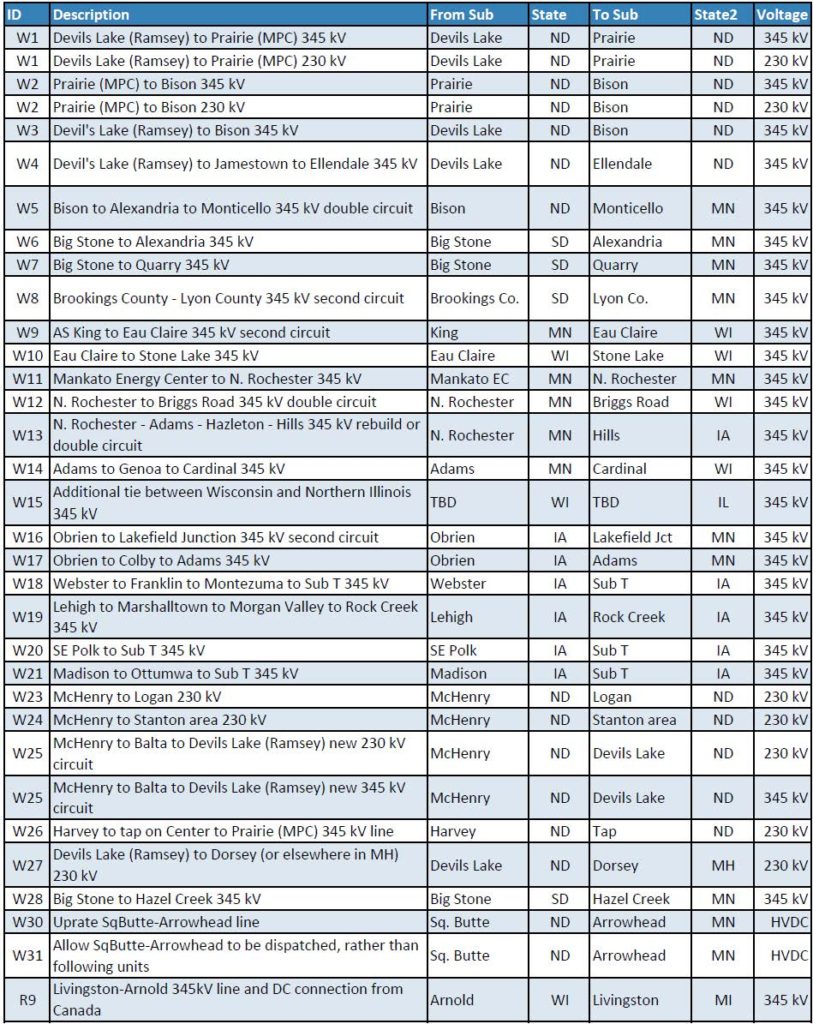
In the process of getting from any Point A to any Point B, we’ve overbuilt transmission to the point that Xcel Energy is whining that the grid is only 55% utilized.
(N) Identify and develop opportunities to reduce customer costs by improving overall grid efficiency. In Minnesota, the total electric system utilization is approximately 55 percent (average demand divided by peak demand), thus providing an opportunity to reduce system costs by better utilizing existing system assets (e.g., generation, wires, etc.). (e21_Initiative_Phase_I_Report, p. 11).
OK, let’s look at “any Point A to any Point B.” Where does this CapX 2020 that started the big transmission build-out start and where does it end (keeping in mind it began with WIREs and WRAO released in 1998, they’ve built almost all of those proposed then)?
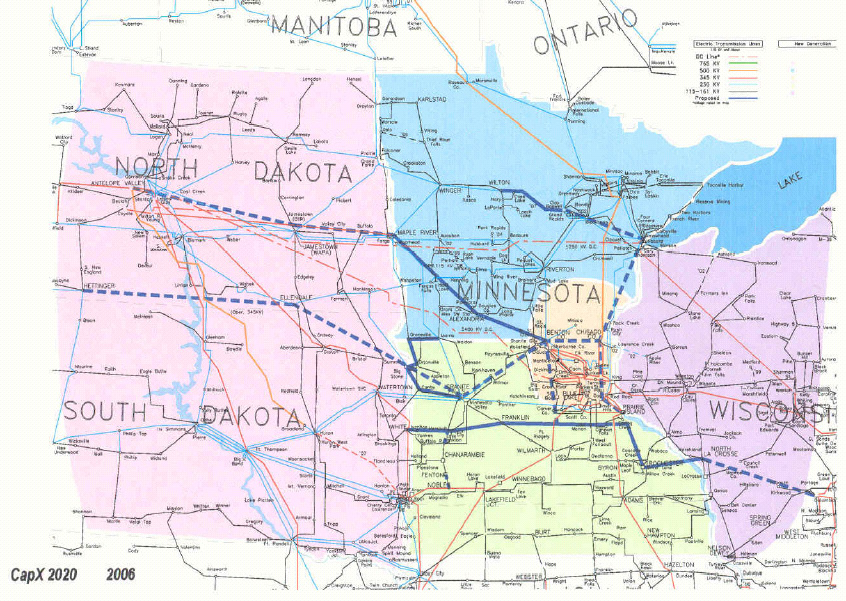
Well, fancy that. It starts in the coal fields of the Dakotas, at the major coal plants fueled by the neighboring coal mines. Oh, and look, it goes east to the Madison ring and off to Illinois… huh… funny how that works… Now, think about what it means for “pass through” Minnesota!
How about the MISO 17 project MVP Portfolio, again, now priced at over $6.6 BILLION (it was $5.24 billion when approved by MISO):

And the addition of the capital costs of these projects to the rates has not been adequately considered. Xcel admits in its latest rate case initial filing (15-826), now water over the dam, that it’s transmission driven. In the CapX 2020 cases that No CapX 2020 intervened in, the Certificate of Need and multiple routing dockets, we were not able to raise rate issues, consistently and adamantly told that no, that can only be addressed in rate cases. Was Center of the American Experiment there? Nope. They were just agitating to get people to comment, but no substance. Maybe if they’d read the rate case dockets, they’d have some credibility, but nooooooo.
Look at PUC Rate Case Docket 15-826, and the one before it, 13-868. What is driving Minnesota’s price is not wind (it’s much lower PPA price than any other resource) but transmission. We’re now paying for CapX 2020 transmission and the MISO MVP 17 project portolio (an apportioned share). Transmission ROI is 12.38%, though it’s in a fight at FERC which will lower it to maybe 9+%, which is much more than they get on electricity because price is so low. We are also now paying for rebuilding the Sherco 3 coal plant which was down for two years after the turbine went wild and blew up, and that rehab was over budget (2 years that power wasn’t needed, but rebuilt it anyway and we’re paying!). And the Monticello nuclear plant rehab and uprate which cost twice as much as they thought (and so because of too high cost and lack of need, they started but then cancelled the same at Prairie Island here in Red Wing). (the electric market is so bad, prices so low, that Xcel is wrangling to have its “business plan” determine rates, not cost! And they want to focus on building things to get that ROI which is a lot higher.) Center of the American Experiment is not a credible source, they do this sort of thing all the time to advance their agenda, and don’t dig into the facts. WindAction latches on to this, without looking for details, facts. That comes out in the rate case.
I tried, both individually and on behalf of No CapX 2020 to intervene in the most recent rate case (15-826) because CapX and MISO MVP transmission is the driver, and got into quite a testy fight with the ALJ, Judge Oxley. He was so extreme in his resistance, worked so hard to exclude No CapX, beyond anything I’ve ever seen before. When I presented at the public hearing, he refused to allow cross examination of the witnesses, said he wouldn’t require their witnesses to be present at the hearing, and started yelling at me, all on the record, and it looked like he was about to start crying, eyes red and watery, shaking visibly. It was so bizarre. Details here – particularly the Denial #2_Overland-NoCapX Intervention where he declared NO, NO intervention in a very pissy way, and despite this being the rate case, and throughout the CapX 2020 dockets (all 5 of them over 8 years!) and ITC’s MISO MVP Line 3, where we were repeatedly prohibited from addressing rate impacts, nope, no intervention in the rate case:
Encourage public participation? Yeah, right…
February 10th, 2016
Public participation? Tough in Xcel rate case
July 14th, 2016
And here’s an interesting tidbit exposing Xcel’s failure to pay taxes, in essence a public subsidy of Xcel:
Xcel Energy Rate Case — taxes & xmsn rider
June 27th, 2016
From my NoCapX2020 site:
Xcel Rate Case in CapX territory
Well, look who’s intervened in the rate case!
Also, note how CAE goes into a spiel about wind “subsidies” but they don’t address that ALL forms of generation are subsidized, with nuclear getting the most expensive of all, coal second (and shall we get into subsidies for failed IGCC/coal gasification? OH MY DOG!). I have no time for these “subsidy” arguments when there’s no charge to remove ALL subsidies for energy across the board. They also talks about wind needing coal as “backstop.” Ummm, no, that’s natural gas. Coal can’t ramp up and shut down quickly. Natural gas can and does. Shame, they should know better… Coal as “backstop.” Good grief. And on top of that, they try to argue that the cost of backup power for intermittent should be considered as part of the cost of intermittent? Oh, right… tell that to the natural gas plant operators, tell that to those negotiating PPAs for intermittent power! What a hoot! FYI, no, it doesn’t work that way.
And here’s a simple way to clairfy — think about what it would mean if they shut down the coal plants, as we keep hearing about… would we need ANY new transmission? And think about what we’re paying in our utility bills to shuffle this power eastward. Which we’ll get back to further down, and now, on to the next point:
Minnesota’s energy policy primarily promotes wind power.
Yeah, that’s true, wind and solar. For years wind has been a “least cost” option, as declared by the Dept. of Commerce and the Public Utilities Commission, as they do the Integrated Resource Planning and review of Power Purchase Agreements. But don’t forget when talking about energy policy, the massive promotion and subsidization of coal gasification, which even with all the push, couldn’t make it. It was tossed out of the PUC based on the outrageous costs, despite the state subsidies from several sources, and federal bankrolling, grants, and subsidies (for more info, search here for “Mesaba” and “IRRB,” “Mesaba” and “DOE” and just “Mesaba” and scroll through. There’s a lot, that was a 5+ year fight.).
CAE states that there will be only “modest increases in solar,” and that’s way off, both for commercial and residential. Watch! FULL DISCLOSURE: My father designed the solar at the Minnesota Zoo (which was hot water, they didn’t know much about that in early-mid ’70s and produced way too much, was taken down, and the pieces parted out across Minnesota — Ralph Jacobson, IPS knows more about that.). Solar is best because it produces on peak, is storable, particularly at a residential level, and it’s right where load is. Why isn’t every big box in Minnesota covered with solar?
Minnesota has also policy-wise, or unwise, pushed biomass, which has been an economic disaster and Xcel Energy has cut the “biomass mandate,” and is trying to get out of the PPAs for biomass plants that they don’t own, and working to slash the price at the HERC garbage incinerator. Biomass, high priced as it is, however, is a very small percentage of total generation.
Minnesota energy policy also focuses on conservation and efficiency. Conservation is by far the cheapest, because if you don’t use it, it doesn’t cost a thing!
And look at Xcel Energy demand over the years:
It’s Xcel Energy’s, and the utility industry world’s, “new normal,” as Xcel’s CEO Ben Fowkes calls it. Here’s their 2017 3Q powerpoint that came out with their 3Q investors call: CLICK HERE! New capital investment of $1.5 billion and “Targeted ownership” = “Steel for Fuel” plan, making money off capital costs, and significant decrease in fuel costs. Base capital plan of $19 billion = ~5.5% rate base growth — that’s the point! Making money in a way that’s not dependent on selling electricity. And slide 10, Minnesota’s 0.5% DECREASE in sales, overall Xcel 0.2% growth. The “new normal.”

Minnesota’s energy policy is falling on its own terms, as it has not achieved a significant reduction in CO2 emissions.
True, but… This is an area of conflatulence. State policy promoting wind DOES NOT EQUAL reduction of CO2 — it only equals building wind. Building billions of MW of wind will not decrease CO2 emissions. Closing coal plants will. Stopping burning will. That’s the only way.
Minnesota has not closed all, or even most, its coal plant generation. We have only closed some of the older coal plants that are not economical to run. Look at Sherco 3, a plant that had a major turbine failure and fire and was off line for nearly two years and was rehabbed to the tune of over $200 million. With that plant off line, CO2 emissions would have been greatly reduced, were in fact greatly reduced, but the Clean Power added those emissions back in for their modeling! WHAT? Here’s the poop on that:
Look at how the “adjusted” Minnesota’s baseline levels due to Sherco 3 being out for nearly 2 years:
The EPA examined units nationwide with 2012 outages to determine where an individual unit-level outage might yield a significant difference in state goal computation. When applying this test to all of the units informing the computation of the BSER, emission performance rates, and statewide goals, the EPA determined that the only unit with a 2012 outage that 1) decreased its output relative to preceding and subsequent years by 75 percent or more (signifying an outage), and 2) could potentially impact the state’s goal as it constituted more than 10 percent of the state’s generation was the Sherburne County Unit 3 in Minnesota. The EPA therefore adjusted this state’s baseline coal steam generation upwards to reflect a more representative year for the state in which this 900 MW unit operates.
Clean Power Plan Final Rule (PDF p. 796 of 1560).
… sigh… much ado about nothing. But remember, it’s not binary. Wind isn’t “replacing” anything. Wind is added on top of the existing generation, of which we have a surplus before it’s even added. Once more with feeling, WIND ISN’T REPLACING ANYTHING! We could shut down those coal plants now and wouldn’t miss them, but then the utilities couldn’t sell the surplus generation, couldn’t make money providing transmission service from Point A to Point B, and couldn’t make money on capital costs of transmission with a much higher return for building transmission than for selling electricity.
Here’s more on that, from a study released when they were working to get the transmission scheme rolling. The purpose of MISO Midwest Market — where ever would I get the idea that the purpose of it is to displace natural gas with coal generation?
Well, look at pps. 14 and 83:
Again, the purpose, to sell from any Point A to any Point B. That’s what it’s all about! It has nothing to do with displacing coal with wind, and it has nothing to do with taking coal off line, shuttering plants, and it has nothing to do with reduction of CO2 through reduction of burning to generate electricity.
To satisfy Minnesota’s renewable energy standard, an estimated $10 billion dollars has been spent on building wind farms and billions more on transmission.
When talking about costs, True, lots has been spent on building wind farms. However, until very recently, utilities have not been spending those billions of dollars, the wind developers and wind companies have, and utilities are buying the energy via Power Purchase Agreement, and not spending the billions of capital costs, instead letting the independent power producers do it. There’s a big difference there between PPA and capital costs, and CAE does not acknowledge it, and does not acknowledge that we’re being billed for PPA costs and not capital costs in most instances.
Billions on transmission, yes, that’s true, as above, but that transmission is not for wind. It’s for wheeling their surplus power through Minnesota and out of the state, whatever power is there, and remember, those lines start at the coal plants! Again, check the ICF MISO Benefits Analysis Study to see why they want to build all this transmission.
$10 billion capital cost spent building wind farms? Compare with the $29 BILLION cost of building two nuclear reactors, 2,200 MW, at Vogtle, which will never run. Building generating plants of any sort costs money. The failed Mesaba Project coal gasification plant was expected to cost, at last estimate by DOE, over $2.1 billion, for 663 MW. Failed Kemper IGCC 582 MW for $7.1+ billion. As of year end, 2016, there was over 3,500 MW of installed wind capacity. $10 billion capital cost? Cost comparison anyone for construction of generation?
I want people to know that relying on pieces like this is not a good idea! Sending around these “reports,” i.e., the CAE “report” with its many misstatements about things where the authors they should know better, is not helpful because it’s a false spin, FAKE NEWS from the masters of misrepresentation. This rate issue and cost of generation, the decreasing demand and increasing conservation, and transmission for coal is something I’ve been enmeshed in for a long, long time, and I can’t let stuff like this slide.
GreenMark & Wacouta Township in Goodhue Co. District Court
September 12th, 2017

I found my notes!! On August 29, 2017, Alan and I went to the Goodhue County Courthouse for the GreenMark Solar v. Wacouta Township (Court Case No. 25-CV-17-1462) festivities — a Summary Judgment hearing.
FULL DISCLOSURE: I’m not a fan of any of the principals of GreenMark, Mark Andrew, Dennis Egan, and Julie Jorgensen. Mark Andrew is a former Hennepin County Commissioner and a fan of burning garbage. Here’s a thread from the Mpls yak-yak list about Andrew when he was running for Mayor. Dennis Egan, well, we had a few go rounds when he was Mayor of Red Wing AND was executive director of Minnesota Industrial Sand Council, and at the time silica sand mining issue was on agenda for City of Red Wing. Julie Jorgensen? Her Excelsior Energy Mesaba Project coal gasification plant took up 5 years of my full-time labor before it went to part-time and intermittent, and still just won’t fully go away! Minn. Stat. 216B.1694, Subd. 3(b)(1)(ii).
That said, I’m also a big fan of solar, from way, way back when my father designed the solar on the Minnesota Zoo (that was later taken down, it was hot water! Not quite what was most needed, and they didn’t know much about solar back then).
Here’s the GreenMark Complaint — couldn’t find the Wacouta Answer or the cross-motions for Summary Judgment. The Wacouta Township website is years out of date — what’s up with that? (2014 is most current minutes, plus a notice of the May 2017 meeting about the solar project. ???)
Here are a couple articles:
GreenMark Solar challenges Wacouta Township | Republican Eagle
Minnesota Developer Sues for Solar Garden Permit
The oral argument started with Greenmark. Some points (not all inclusive):
Focus on Minn. Stat. 394.33, Subd. 1, that the township decision violates Town Powers Act. It’s inconsistent with their zoning. They can enact more restrictive zoning, but they didn’t, township has no solar ordinance.2
Township ordinance is ambiguous. Frank’s Nursery case — if ambiguous, allow property owner to do what they want with the property.
“Agricultural community” — Planning Commission and Board selected different definitions. Current use, peat mining and hay. Pollinator scale 45, and 85 with solar. Wetlands. Reduce carbon emissions.
Township argument:
Town Power Act does not restrict township actions. Bergen defines inconsistent, it’s not different.
Township Ordinance, Art. 3, Subd. 10, limits industrial uses that do not support agricultural. Solar is an industrial use. Twp. does allow solar in ag, BUT, it’s more restrictive, and it’s not inconsistnet.
The standard is whether down decision was rational, i.e., legally sufficient, supported by record.
Reasonable — inconsistent with agriculture, exported to the grid. CUP – exported, GreenMark takes issue with def of ag use, but see “Hubbard Broadcasting” denial of Conditional Use. Review is deferential. Mandamus (GreenMark’s action) review not to challenge discretionary decisions of local government.
Frank’s Nursery re: ambiguous ordinance, doesn’t require ordinance to be construed to support use. Court still needs to determine rationality.
Greenmark Rebuttal
Mandamus – this is about building permit, a ministerial act, not discretionary.
Does township even have jurisdiction/authority.
Purpose of project — Goodhue County, that’s the area.
Altenberg (?) – Town Powers Act – Twp didn’t adopt a more restrictive ordinance.
Bergum (?) – legislative intent of Town Powers Act.
Township Rebuttal
Cases of Mandamus for building permits
Goodhue – zoned agricultural, township couldn’t zone industrial, that would be inconsistent with county zoning.
__________________________
Judge Bayley said he has a lot of homework to do, and will do it and issue Order.
CO2 pipelines? It’s a red herring!
March 22nd, 2017

The Great Plains Institute has long been a problem, and it remains a problem, evidenced in today’s missive trying to bootstrap onto tRump’s “infrastructure” agenda, by releasing a “White Paper” “calling on President Trump and Congress to make CO2 pipelines a priority component of a broader national infrastructure agenda and recommending that the federal government support the development of CO2 pipeline networks.” Oh, great… brilliant idea, just brilliant.
Great Plains Institute a problem? Yes. They were paid handsomely to promote coal gasification, projects including but not limited to Excelsior Energy’s Mesaba Project, the boondoggle of boondoggles. For example:
Great Plains Institute – is Joyce getting their $$ worth?
January 18th, 2007
Carbon capture and storage/sequestration was seen by many circa 2005 as a “way forward for coal.” So the Walton’s Bill Grant said. No. It wasn’t.
CO2 sequestration is so… like… not happening!
It wasn’t a “way forward for coal” then, and it isn’t now.
The market has spoken on coal, and it’s clear that coal is on the way out as coal companies go bankrupt, as coal generated electricity languishes on the energy market, and as the inefficient and costly older coal plants have closed, with newer larger plants waiting in queue to be shuttered.
And CO2 capture and storage/sequestration is a farce. Why? Well, we learned a lot about CO2 capture in our fight against Excelsior Energy’s Mesaba Project. That’s where the Public Utilities Commission determined that it was just to expensive and risky to approve a Power Purchase Agreement — go HERE and search for PUC Docket 05-1933. Here’s a rough visual of CO2 capture and storage/use:
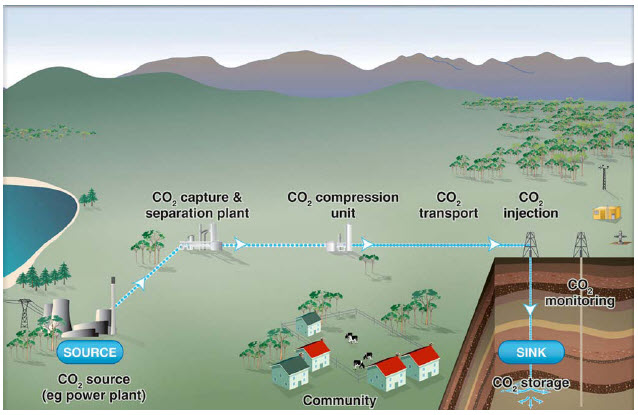 From Global CCS Institute HERE
From Global CCS Institute HERE
So what’s the problem?
- First, capture is costly and difficult, particularly capturing any significant portion of CO2 generated.
- The higher percentage captured, the higher the cost of that capture, and high percentage capture has not been achieved.
- The cost of capture is not only the cost to physically do it, the hardware, technology, and engineering, but there is a high cost in efficiency of the CO2 producer, a parasitic cost, meaning that if you’re capturing that CO2, you’re paying a high price in efficiency of an already inefficient process (burning is always inefficient).
- And another parasitic cost, these pipelines require pumping stations to pressurize andpump it into the pipeline, a pumping station every 75 miles or so to keep that pressure up, and a pumping station at the destination, and those pumping stations require 4-10 MW of power, depending.
- Environmentally, the impacts of digging up land for hundreds of miles is immense.
- These are private projects and for a private project, a private purpose, eminent domain isn’t available for the taking of people’s land.
Yet this CO2 capture and storage/sequestration farce continues, evidenced in the most recent Great Plains Institute missive I found in the inbox, here the missive’s link to CO2 capture and storage for oil extraction, “Enhanced Oil Recovery”.
Here’s their “White Paper” with what they’ll be lobbying for:
Short version: The federal government should make this CO2 pipeline and infrastructure build out happen across the country, a la the Interstate highway system.
In light of tRump’s Executive Order 13766, Expediting Environmental Reviews and Approvals for High Priority Infrastructure Projects, that’s a scary notion.
Check out this site from Global CCS Institute, and note, they talk of benefits, but look for talk of costs. Hmm…
A “way forward for coal?” CO2 capture? Over my dead polar bear.
Gangs of America – good reading these days
February 9th, 2017
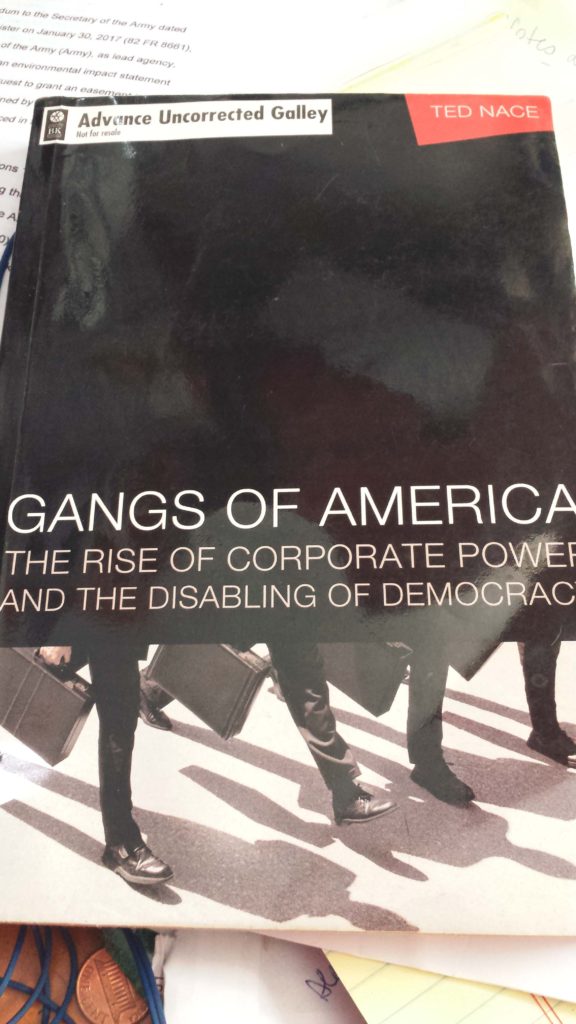
Looking forward to catching up with Ted Nace soon in San Francisco. He’s author of Gangs of America: The Rise of Corporate Power and the Disabling of Democracy — get your copy HERE.
Alan Muller and I had the good fortune of meeting him through our “no coal” work and the “No New Coal Plants” list that was instrumental in stopping so many coal gasification plants across the U.S., including Minnesota’s Excelsior Energy Mesaba Project (see also www.camp-site.info)and the NRG coal gasification plant proposed for Delaware. He wrote this Orion article about that coal gasification fight (a couple things are off — hey, Ted, it’s an ORANGE crate!!):
And from that, he also also wrote:
Climate Hope: On the Front Lines of the Fight Against Coal
Check these out, you can find them reasonably priced at www.abebooks.com. Support your independent bookseller!
MN’s Renewable Development Fund HF235/SF214
February 3rd, 2017

Some have said that the Renewable Development Fund is sacred. WRONG. The Renewable Development Fund is profane, not sacred, all the way from its origins to its uses. It’s now under scrutiny at Minnesota legislature, and institutional memory is nowhere to be found in this discussion. See HF 235 and SF 214.
The Renewable Development Fund (RDF) came into being in the 1994 Prairie Island bill, and was to be a per cask compensation fund for the Prairie Island Indian Community for storage of nuclear waste next door and extension of Prairie Island nuclear plant life. That compensation was turned into the RDF in a late night deal by “environmental” groups lobbying, of which Bill Grant (now Deputy Commissioner, Dept. of Commerce, formerly and then Izaak Walton League) was an integral part, Michael Noble (ME3, now “Fresh Energy”), and George Crocker (North American Water Office) too. Prairie Island Indian Community was supposed to get priority in grants, but that never happened. The RDF was administered by 3 from Xcel, plus Bill Grant, and one other “environmental” rep. The composition of the group giving out the grants has changed, and there is now someone from PI on it, but that’s recent. (Full Disclosure: I represented Florence Twp. fighting the “in Goodhue County” alternate site mandate for nuclear waste and the Township worked very mindful of, and often in tandem with, PIIC, where it fiercely refused to acquiesce to Xcel and say “STICK IT THERE” to PIIC. The working relationship continues and PIIC is now largest private landowner in Florence Twp.).
1994 Prairie Island bill — Ch. 641, MN Session Laws (https://www.revisor.mn.gov/laws/?year=1994&type=0&doctype=Chapter&id=641).
The RDF was a material term of the 2003 Prairie Island bill, where as part of the deal millions of RDF money was to go to the Excelsior Energy Mesaba Project. Bill Grant was primary again, and when the Mesaba Project was stricken in one House session, a red-faced Tom Micheletti came flying down the hall yelling at Grant “We had a deal, we had a deal!” That deal was later added back in, and Micheletti’s Excelsior Energy coal gasification plant, Mesaba Project, was added to the factors to keep PI open. “Environmental groups” got massive grants to promote coal gasification. Micheletti got $10-12 million from RDF for Mesaba (and lots more from IRRB and DOE) and other regulator perks in the 2003 law, like exemption from CoN, and a mandated PPA with Xcel. (Full Disclosure: I represented MNcoalgasplant.com against Mesaba Project, and with CAMP and help from Xcel, we got the details of coal gasification, that project was killed, and the info killed others nationwide, but Mesaba still has a site permit in Taconite from PUC valid until 2019!)
2003 Prairie Island bill – Ch. 11, MN Session Laws (https://www.revisor.mn.gov/laws/?year=2003&type=1&doctype=Chapter&id=11)
On Monday, January 23, the Red Wing City Council voted to accept a $2 million grant from RDF to install a garbage grinder, a project they’ve been lobbying for for years, where they’ll take in garbage from the whole county, grind it up, and burn it in Xcel’s garbage burner here, its air permit expired in 2009! GARBAGE!!! DOH! GARBAGE is not clean, it’s toxic! The purpose of all this is to keep the incinerators open and burning. (Full Disclosure: I have been representing clients being screwed by Xcel’s plan for “ash mining” in their incinerator ash landfill in Red Wing, part of which includes a plan to build a Red Wing laydown yard and crusher on a site half of which is designated Water Tower Burial Mounds — yeah, really. That’s been exposed:
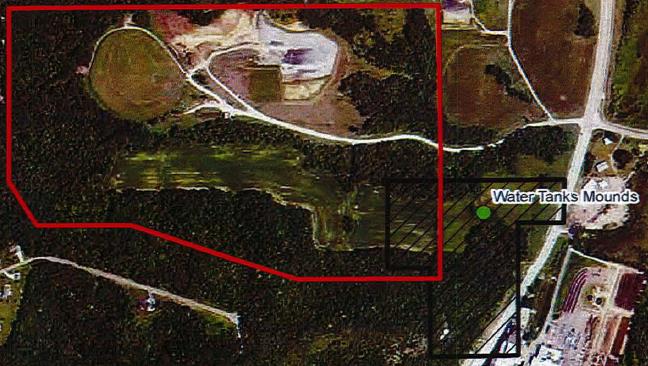
My partner, Alan Muller, is an incineration expert and has worked with groups to stop RockTenn; Midtown Burner in Phillips, Rockford City and Township; HERC uprate, etc. See the Tyler Hills Neighbors Comments: Comment Extension for Lab USA EAW & Xcel & Lab USA Solid Waste)
The RDF has been a slush fund for deals enabling nuclear, promoting coal gasification, and greasing the skids for scams of great financial and environmental magnitude and impact. It should be shut down and turned over to Prairie Island Indian Community as originally intended.
